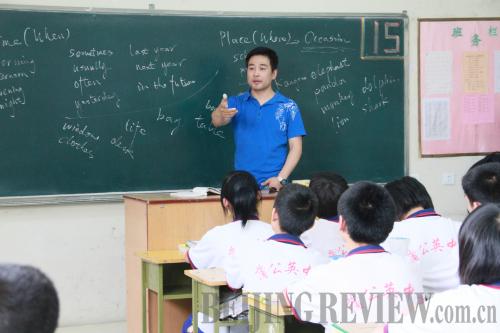|
 |
|
PHYSICALLY STRONG: Girls in Dandelion Middle School in a physical education class (MA XIU) |
On a drab street lined with low-rise shops, restaurants and shish kebab stalls, Dandelion Middle School is hardly noticeable. In the July rain, the run-down street in a Beijing southern suburb even looks a little dreary.
Behind a large, old-fashioned iron gate is the campus of Dandelion Middle School, the first, also the only, government-approved middle school for children of migrant workers in Beijing. Currently, more than 600 students are enrolled.
The school's name indicates the characteristics of its students, who are like dandelions, ordinary plants that need little to survive and can grow and bloom anywhere.
Right to education
Dandelion Middle School is a non-profit private school established in 2005. Its founder, Zheng Hong seeks to give migrant children a quality education. Zheng holds a Ph.D. from the University of Geosciences in China and an MPA from Harvard University's Kennedy School of Government.
The campus is clean and reasonably spacious. It used to be a factory producing switches. The paintings on the walls give it an artistic touch. A huge "welcome" sign adorns the wall beside the entrance gate in both Chinese and English.
Between classes, boys and girls play basketball or table tennis in the yard. Meals are usually brought to classrooms from the kitchen. After dinner, they study in the classrooms before returning to the dormitory at around 8:30 p.m.
The school has dormitories for students and teachers, a library, laboratories for numerous science classes, and an auditorium.
The classrooms and dormitories for Grade 7 are in a bungalow in the front yard. They were humid and stuffy after the rain. In a dormitory, several bunk beds were put next to each other. There were no tables, chairs or decorations of any sort.
Private migrant children's schools came into being as migrant workers flocked to cities, some bringing their children with them.
School-age children migrating to Beijing increased from about 66,000 in 1997 to 400,000 in 2008, according to research done by Liu Chengfang, a senior research fellow at the Center for Chinese Agricultural Policy at the Chinese Academy of Sciences.
 |
|
VOLUNTEER IN ACTION: Ji Xiaojun, an anchor man at China Central Television's English channel, teaches a class at the Dandelion Middle School on June 8 as a volunteer (JI NAN) |
Migrant children brought with them an educational conundrum in China—they could not access free compulsory education in urban public schools. According to the Compulsory Education Law of China published in 1986, local governments in their places of origin should be responsible for providing them free compulsory education.
As the number of school-age migrant children grew, education became a pressing issue. In 1998, the Ministry of Education and the Ministry of Public Security published a provisional regulation on schooling for migrant children. The provision gave a green light to private schools for migrant children, and permitted the schools to meet lower standards compared to regular full-time schools.
After the regulation, migrant children schools mushroomed. Liu found the number of migrant children schools in Beijing went up from less than 50 in 1997 to about 200 in 2000. In 2008, about 300 such schools were still running.
However, most of the private migrant schools are not authorized by the government. Some school headmasters and teachers themselves are poorly educated. China Youth Daily reported one headmaster of such a school only had a two-year primary school education.
The father of a student surnamed Shang at the Dandelion Middle School talked about the experience he had with a private school for migrant children his son attended.
"That school was awful," Shang said, accusing it of being more concerned with revenue than quality education. "As long as students were safe and sound in the school, the teachers felt okay. They did not teach much. In fact, I taught my son more than the teachers."
Shang is a migrant worker in the clothing industry. He and his wife, natives of Hubei Province, came to Beijing after working in south China's Guangzhou City, Guangdong Province, for several years. Shang brought his son with him wherever he worked. He says the teachers at Dandelion are very responsible.
"In Dandelion Middle School, we have taken several measures to ensure teaching quality," said Cheng Jianfang, the school's teaching supervisor. The school recruits teachers with educational backgrounds in normal schools and with teaching licenses. Teachers are required to write teaching plans and at times present them in front of other teachers and listen to each other's classes. School leaders randomly drop into classes to monitor teaching quality.
"We can tell whether a teacher is devoted. If a teacher is devoted, he or she will do a good job," Cheng explained.
These measures give incentives for teachers to improve. Because salary paid at the school is relatively low compared with the average teacher's income in Beijing, it is difficult to attract experienced teachers from public schools, Cheng said. Most of the teachers working at the school are from other provinces, and did not have much teaching experience when they started. The school offers them on-the-job training and has a teacher exchange program with top middle schools in Beijing.
The students make progress at the school, Cheng said. Many new students did poorly when they just moved in. Last year, the school recruited 220 students and only five of them passed all the three subjects at the entrance examination for junior middle school. After studying for three years, students took the same high-school entrance exams as regular students in Beijing. During the past two years, 98 percent of the students taking the exam passed.
"We not only improve the students' knowledge, but teach them to be a good person and improve their overall qualifications," said Cheng.
| 